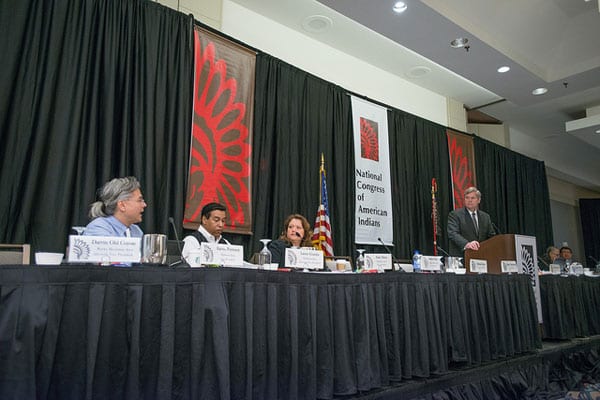
January 1, 2019; New York Times
At thirteen days and counting, this partial government shutdown is now the second-longest shutdown in the last two decades, the fourth-longest in history, and the third for the Trump administration. While only a fourth of government spending is technically affected, so the impact is “limited,” those living in Indian Country are reeling from the devastating effects.
For Indian Country, a government shutdown means more than closed museums. Rather, it means lack of access to basic services, which the federal government is obligated to provide from trust and treaties signed centuries ago. Between the late 18th and 19th centuries, the United States and Native American peoples signed around 400 treaties. These treaties essentially gave the US government land once held by American Indian nations in exchange for land reservations and a guarantee that the US government would recognize Indian tribes as sovereign domestic dependent nations. The 1977 Senate report of the American Indian Policy Review Commission describes the trust relationship as follows:
The purpose behind the trust doctrine is and always has been to ensure the survival and welfare of Indian tribes and people. This includes an obligation to provide those services required to protect and enhance tribal lands, resources, and self-government, and also includes those economic and social programs which are necessary to raise the standard of living and social well-being of the Indian people to a level comparable to the non-Indian society.
These treaties guaranteed the protection and well-being of federally recognized tribes, coming from government-to-government relations, which now takes the form of federally funded services. Those services, including disaster relief, police protection, health clinics, and food, are now being denied to Indian Country during the shutdown. For more information about how Indian Tribes are affected during a shutdown, please read Rick Cohen’s “Indian Tribes Try to Cope with Shutdown,” which dates to 2013.
Sign up for our free newsletters
Subscribe to NPQ's newsletters to have our top stories delivered directly to your inbox.
By signing up, you agree to our privacy policy and terms of use, and to receive messages from NPQ and our partners.
Aaron Payment, chairman of the Sault Tribe of Chippewa Indians, argues, “The federal government owes us this: We prepaid with millions of acres of land. We don’t have the right to take back that land, so we expect the federal government to fulfill its treaty and trust responsibility.”
The Sault Tribe of Chippewa Indians has been using hundreds of thousands of dollars of their own reserves to keep afloat. Payment estimates, “Currently, the cost per day is about $100,000; we have reserves to be able to cover that our council has appropriated. We’ve probably eaten about half of our reserves and support dollars since the shutdown happened.”
Russell Begaye, the president of the Navajo Nation, said his tribe has been in a dire situation because of a snowstorm that hit parts of Utah, New Mexico, and Arizona. According to Begaye, “The Bureau of Indian Affairs under the Department of the Interior, they normally maintain the roads. Much of that is dirt road, and a lot of our people living out in the rural areas are not able to get out of their homes because the roads are ice-packed and snow-packed, and if it starts to melt, it gets muddy. So, our people basically can’t get out.”
With Trump showing no sign of letting up on his border wall, indicating, “I would look foolish if I did that,” an end to the shutdown is not in sight. While the government is without a doubt failing to fulfill its trust and treaty obligations, as NPQ noted during last year’s shutdown, nonprofit organizations may called upon to fill the gap until services are back in place for Indian Country.—Sheela Nimishakavi












